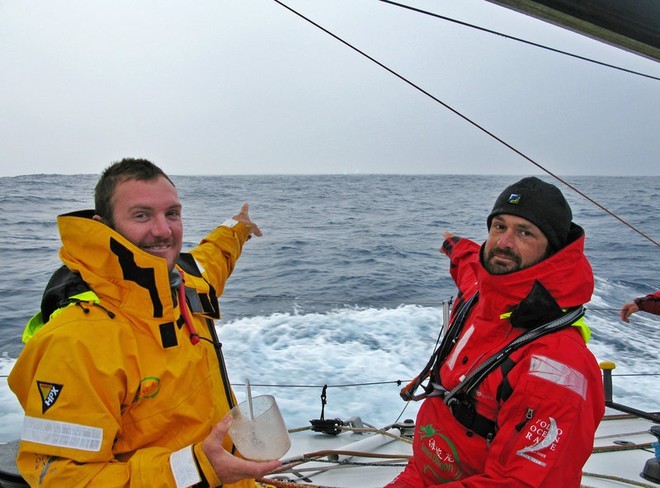Volvo Ocean Race- Skirting the Southern Ocean icebergs + Video
by Jonno Turner on 1 Nov 2014

Green Dragon See Icebergs in the Southern Ocean, on leg 5 of the Volvo Ocean Race, from Qingdao to Rio de Janeiro Guo Chuan/Green Dragon Racing/Volvo Ocean Race
http://www.volvooceanrace.org
They lurk in the dark, depths of the ocean, sometimes revealed only by a sharp apex standing proud above the surface.
No, not sharks – but they’re just as scary, and they can be just as deadly.
'You know they’re around, because you can smell the stale water, and feel the temperature drop – especially at night, or when it’s foggy,' explains Justin Slattery on board Abu Dhabi Ocean Racing.
He’s talking about icebergs. Massive chunks of thick, jagged frozen force. Floating fast, recklessly and aimlessly in the ocean.
Some are as big as the chair you’re sitting on, others the same size as a family car.
If you’re really unlucky, you might have to swerve one as big as a house – or a small city.
But in truth, even a block the size of a regular TV set, floating inconspicuously below the surface would be enough to put a hole in one of these racing machines, hurtling through the water at speed.
'It doesn’t take much to sink a boat like this,' Justin adds. 'The growlers are the worst, because they’re the ones you can’t see – and the ones that don’t show up on the radar.'
The Irishman has just started his fifth Volvo race, and has seen plenty of these bergs in his time – too many for his liking, in fact.
'I remember that the first was exciting,' he smiles, pausing. 'We went down to about 60° South and we saw loads of ice. But then I never wanted to see one again.'
This time, the fleet won’t be heading that far south – but they’re still likely to hit the mid-forties, dropping as low as possible in the search of a cold front blowing in from the west.
Justin continues. 'The growlers are probably the worst, because they’re the ones you can’t see and the ones that don’t show up on the radar.'
'With 90% of their body under the water, if you hit one of those, it’s going to be catastrophic.'
That’s why the race committee has implemented a new rule – an ice exclusion zone that the teams are forbidden to enter.
'We found one piece of ice more than 300 metres in size,' explains in-house meteorologist, Gonzalo Infante.
'But they’re normally surrounded by smaller pieces. That’s why we made the exclusion zone.'
'We use satellite technology to scan the ocean surface. It’s like an altimeter – it spots a bump, and then processes that image, that’s usually invisible to the human eye, with a special software.'
So what exactly is the exclusion zone? Well, it’s basically an invisible wall between 42°00 South, 10°00 West and 20°00 West.
At the back of the fleet, Team SCA’s Sam Davies is behind the decision – and also sees a positive strategic side to the ruling.
'For us, maybe it’s a good thing as it makes it harder for the leaders to escape!' she smiles.
'It’s a racing environment, it’s a pretty dangerous thing to come across, so I totally understand the decision and I think it’s a very good idea.'
She pauses. 'I’ve seen one iceberg in my life for real. It was mixed emotions because it’s a really beautiful natural thing to see, nature at its best.'
It’s the quickest and safest way of ensuring that the teams stay out of danger - but it also provides a tricky test for the navigators, who might have been banking on sailing straight through the middle of it.
'Here we are in the South Atlantic – here’s Cape Town – and here in the middle is the zone,' explains Simon Fisher, sitting down below in the dark of the Emirati boat.
'It keeps us in a safe spot – but it also means we can’t dive south and get more of the westerlies that we’d like.'
There’s a hint of frustration in his voice, and it’s probably the product of leading a race, and being told to change strategy.
He’s pointing at a pixelated projection, red lines outlining the no-go area. But in reality, there are no waypoints, lines, or ‘do not cross’ signs.
In fact, there’s not a lot at all.
'The big picture is that we’ve got to get south,' says Team Alvimedica’s Will Oxley, a marine biologist, staring into the foggy abyss on the horizon.
'But the GRIB files get inaccurate at the finer scale because there are very few people silly enough to be out here.'
He chuckles. 'There are probably only about five observations in 10,000 square miles.'
And that sums up just how barren and dangerous – and downright random - it can be in this patch of ocean.
'It’s getting colder, and the boys are hedging their bets on when to change to their rubber lined boots – I did it about an hour ago,' adds Dave Swete.
'I think everyone’s a bit apprehensive about how cold it’s going to get.'
If you want to link to this article then please use this URL: www.sail-world.com/128460